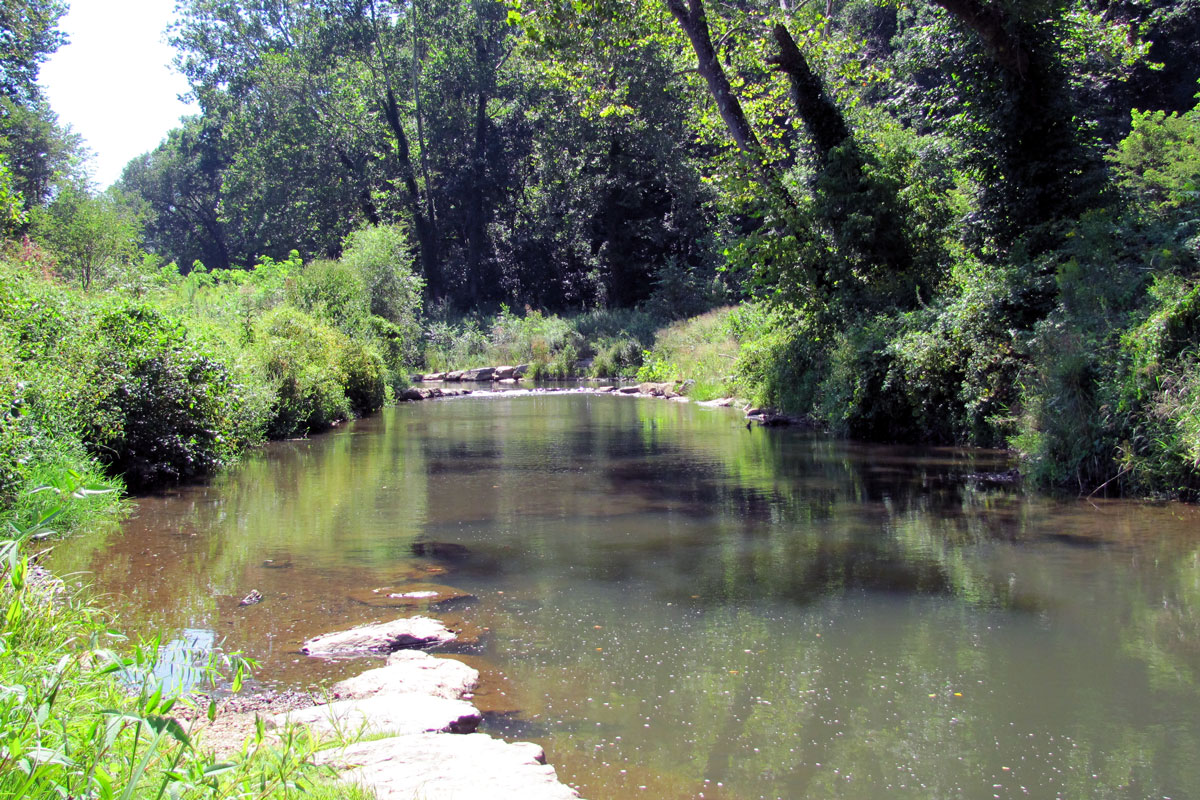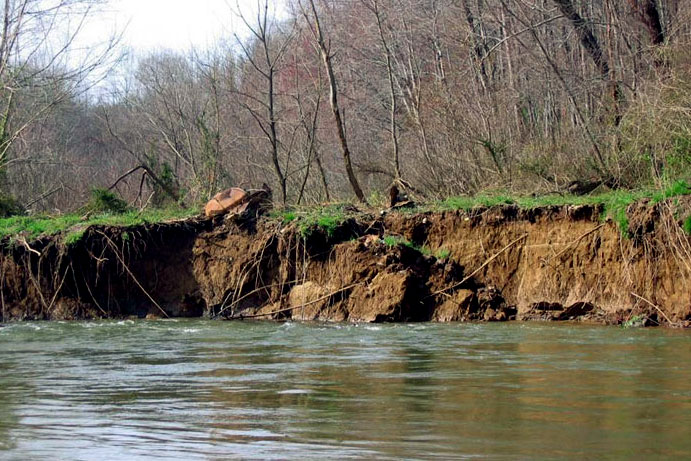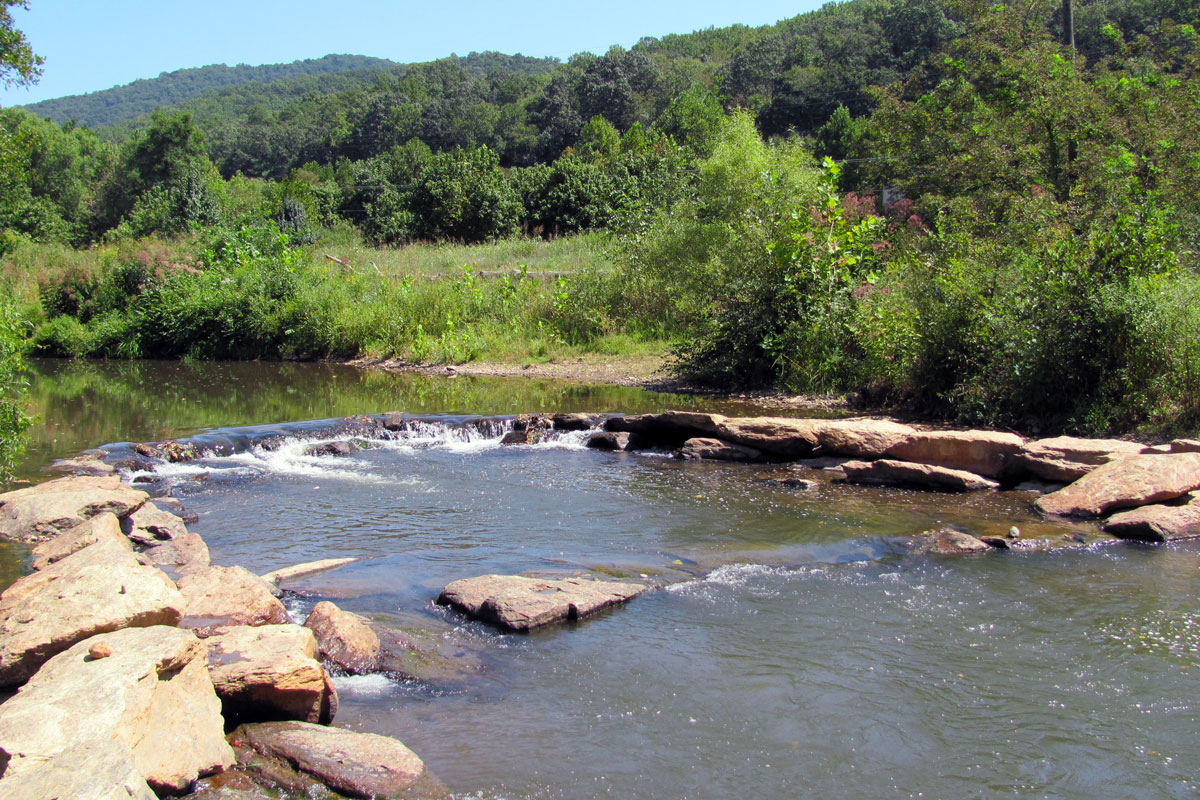
A Watershed-Wide Approach
In 2001 RiverLink embarked on a watershed-wide approach to stormwater management, with the goal of improving water quality in the Swannanoa River Watershed by treating non-point source pollution and engaging in two stream restorations. The Swannanoa River is a major tributary to the French Broad River, traveling 22 miles to the confluence with the French Broad at the Biltmore estate in Asheville. Its headwaters begin in Black Mountain and include the North Fork and Bee Tree Reservoirs, which supply drinking water to Asheville and other Western NC residents.
In 1998 the NC DENR Division of Water Resources (DWR) identified water quality issues within the Swannanoa River Watershed, resulting in impaired water health in portions of the river. Residential and commercial development over the recent decades increased sediment-laden runoff and contributed to poor water quality in the Swannanoa. The 2005 French Broad Basin Plan identified habitat degradation, poor quality riparian buffer zones, nutrient enrichment, sedimentation, channelization and toxicity as primary water quality problems in the Swannanoa Watershed. In 2006, two segments, totaling 14 river miles, were added to the EPA impaired streams list and remained on the list until 2011.
In 2011 NC DWR removed the Swannanoa River from the impaired streams list, due to improved water quality and reduced sedimentation in the river. The stream restorations and stormwater best management practices (BMP’s) implemented through RiverLink’s watershed-wide approach were a major contributing factor to the improvement in water quality. The projects discussed below all treat non-point source pollution in the watershed, as well as provide an educational resource and proven examples that others can learn from and implement themselves.
Azalea Park – Swannanoa Stream Restoration
The Azalea Park stream restoration project is one of the largest stream restorations to be implemented Western North Carolina. With support from the Clean Water Management Trust Fund, the City of Asheville, Azalea Park area residents, and a team of engineers, RiverLink restored approximately 1.5 miles of the Swannanoa River as it runs though Azalea Park. The goals of the project were to stabilize and protect stream banks along 1.9 miles of the main stem of the Swannanoa River, to improve water quality and aquatic habitat, and protect and enhance riparian buffers (avg. 150 ft.) through conservation easements.
Azalea Park and the John B. Lewis Soccer Complex is a 155 acre city owned property in East Asheville on Azalea Road. Its amenities include soccer and baseball fields, walking paths, and water access for fishermen and birders.
RiverLink staff participated on the park design committee and felt a need to enhance and protect the natural resources that exist within the park. A logical choice was the Swannanoa River. The main stem of the river flows through the Blue Ridge Parkway property and bisects the park for over a mile. Over time the river was moved to make way for agriculture in the valley, its riparian buffer was severely diminished in size, and upstream development increased the amount of stormwater runoff entering the waterway.
These changes resulted in severe bank erosion that increased the amount of sediment input to the stream, while lack of sufficient riparian buffers caused stream temperatures to warm in the hatchery supported trout waters. Both of these factors significantly impacted the ability of trout to reproduce in the Swannanoa River. RiverLink received grant monies from the North Carolina Clean Water Management Trust Fund to help stabilize the river banks and improve riparian habitat throughout Azalea Park.
RiverLink, the City of Asheville, Wolf Creek Engineering, and North State Environmental completed a priority II restoration on 1,100 linear feet of stream, and stream bank enhancement and stabilization on 2,000 linear feet of stream. Much of the in-stream work focused on redirection of stream flows from eroding banks and the creation of a series of pools and riffles in appropriate sequences. This decreased the amount of sediment entering the stream and increased the amount of oxygen in the water. This, along with the root wads and logs that were placed in the stream, greatly enhanced aquatic habitat.
A 27 acre conservation easement along both sides of the Swannanoa will help to preserve new buffer plantings and protect them until maturity. A 7.8 acre wetland is also located at Azalea Park, and is an excellent site for birders looking for migratory fowl as well as waders. This area is also protected with a conservation easement preserving it for future generations.
Swannanoa Stormwater Improvement Project
RiverLink received grant funding to implement phase I of the Swannanoa Stormwater Improvement Project, which includes 4 urban BMP’s and a small stream restoration, all intended to treat non-point source runoff from urban areas within the Swannanoa watershed. The goal of these projects is to provide examples and educate residents, developers, and local governments about preventing non-point source pollutants from entering our streams and rivers. Five projects have been installed within the watershed to demonstrate a variety of measures that can be replicated elsewhere.
Charlie Bullman Athletic Facility, Haw Creek
The Haw Creek Restoration Project demonstrates stream restoration techniques that reduce sediment and stormwater runoff by stabilizing banks with native riparian plantings, and treating stormwater with bio-rentention cells and vegetated swells.
Sections of Haw Creek were previously straightened, eliminating much of the natural pool and riffle structure that occurs in streams. The first phase of the project reconfigured the flow pattern of a section of Haw Creek, creating a meandering path to allow for more pools and riffles. This not only provided for a more stable stream but it also increased biodiversity of habitat for associated aquatic species. Following reconstruction, native riparian plants were introduced to help stabilize the stream bank.
The second phase of the project addressed sediment runoff from the athletic fields. Sediment is the number one polluter in the French Broad River Watershed, and this project eliminated much of the sediment that was entering Haw Creek by using vegetated swales and bio-retention cells to filter the sediment before it reached the stream.
This site has excellent educational possibilities with students from Haw Creek Elementary and Evergreen Community Charter School within walking distance. This project also provided educational signage and access points for stream related learning experiences.
Evergreen Community Charter School
The goal of the Evergreen Community Charter School project was to provide a multi-faceted approach to the treatment of stormwater runoff, while providing expanded educational opportunities for students. To acheive these goals a rain garden that provides treatment of roof runoff (which contains nutrients such as nitrogen) and enhances the educational opportunities for the science based curriculum (i.e. butterfly garden) was installed. The parking lot was also sloped to capture and treat stormwater containing gas and oil contaminants and direct the water for filtration in a vegetated swale.
Both systems were designed to capture the first inch of rainfall, which contains the vast majority of pollutants. Overflow from both of the systems, in addition to runoff from roadways, is directed to another vegetated swale that reduces the water’s velocity, and finally the stormwater is treated once again in a small wetland. The wetland also provides additional educational opportunities to study a unique biological habitat right on campus.
Jones Residence, Haw Creek Community
The Jones property project was an opportunity to demonstrate practical methodologies for homeowners to improve water quality through reduction of erosion and treatment of stormwater runoff. The property is bisected by Haw Creek and one of its tributaries. Stormwater runoff from Haw Creek Road regularly flowed through the property and entered Haw Creek. A stormwater wetland (made up of native plants) was designed to stop direct input into the stream, and slow the water’s velocity allowing for percolation into the ground, thus reducing the amount of non-point source pollution entering the stream.
Streambank erosion continues to be a problem for many areas of Haw Creek, where vegetation is sparse. The second phase of this project involved removal of invasive exotic plant species from the riparian buffer areas and replanting with native trees, shrubs and groundcovers. This helped stabilize the stream bank, which reduced sediment loading and provided shade to help maintain cool water temperatures.
Black Mountain Well Lot behind Arts Center
Two bio-retention cells (rain gardens) were installed to treat roof runoff from adjacent buildings (Black Mountain Center for the Arts and the Swannanoa Valley History Museum). The runoff is collected and filtered by soil percolation in the two landscaped bio-retention cells. The parking lot was graded, sloped, and resurfaced to allow for stormwater runoff to be treated in a vegetated swale that slows the velocity of water runoff. This helps remove sediment and associated parking lot pollutants (i.e., grease, oil, gas, and heavy metals like zinc, cadmium, etc.).
RiverWalk Park, Black Mountain
The RiverWalk Park Project was designed to treat stormwater runoff from the building’s roof and parking area. A bio-retention cell rain garden was installed to capture and treat runoff from approximately 1.5 acres of impervious surface. The bio-retention cell was sized to capture the first inch of rainfall and allow sediment and nutrients to settle and filter through the soil for approximately 24-48 hours. This process slowly releases stormwater and captures pollutants that are bonded to soil particles and deposited, along with sediment, within the bio-retention cell.
An additional bio-retention area and a stormwater wetland were constructed onsite to treat stormwater runoff from the adjacent railroad. Appropriate native wetland plants were used on all projects to provide for nutrient uptake and aid in the decomposition of pollutants. All of these projects were designed to both educate the public and demonstrate new stormwater treatment technologies for students, developers and decision makers.


